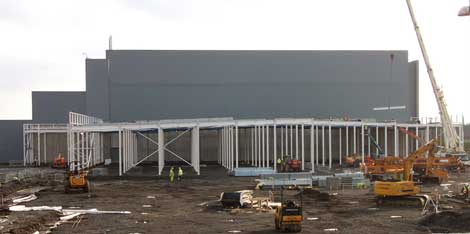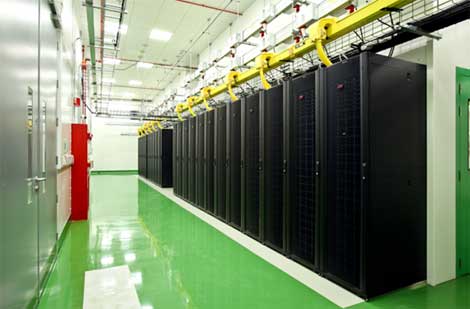
Racks of servers housed inside the Microsoft data center in Dublin, Ireland, which is undergoing a major expansion. (Photo: Microsoft).
Microsoft will add 13.2 megawatts of capacity to its data center in Dublin, Ireland, which powers its online services throughout Europe and the Middle East, the company said today.
The new expansion will feature enhancements of energy efficiency features that debuted in the first phase of the Dublin facility, which was one of the first major data centers to rely almost entirely on outside air to cool servers.
Microsoft will invest $130 million in the expansion, which is driven by the growth of its online services, including Windows Azure, Office365, Bing, Hotmail and Xbox Live. The company expects the additional 112,000 square feet of space to come online before the end of 2012.
The expansion is being built as a second structure adjacent to the existing 300,000 square foot, two-story data center, which opened in July 2009 and is approaching its total IT capacity of 16 megawatts of power. The new building will be significantly smaller, with just one story and a lighter construction frame.
Ditching the DX Cooling Units
It will also be missing a key feature - the DX (direct expansion) cooling units that supported the first phase. The Dublin data center was designed to be cooled with outside air, with the DX units available for backup cooling if the temperature rose above 85 degrees.
"What we found is that with the conditions in Dublin, we didn't use the DX units even once," said Dileep Bhandarkar, a Distinguished Engineer at Microsoft. "It's an optimization of the previous design."
The temperature hasn't gone above the 85-degree mark, Bhandarkar said, adding that Microsoft has concluded that any unseasonably warm days in Dublin can be managed with air cooling.
The Dublin expansion will retain the data hall design of the project's first phase, which featured servers within a hot aisle containment system atop a slab floor. Cold air enters through air handlers on the roof, drops into the data center.
Variations in Design
That's a different design approach than Microsoft's newest data centers in the United States, where it is using modular units known as IT-PACs that house servers within a 20-foot enclosure, allowing granular control of airflow within the container. The differences between the U.S. and Dublin designs is guided by the workloads each facility is handling, according to Bhandarkar.
But Microsoft's focus on using fresh air for cooling extends to the new phases of its U.S. builds, including projects in Boydton, Virginia and West Des Moines, Iowa.
The new building in Dublin is designed to add capacity in 4.4 megawatt increments. The structure features concrete foundations and a concrete floor supporting a modular steel frame that is assembled on-site. The frame will be sheeted with a metal cladding and the roof will be concrete to hold the air handling units.
The Microsoft project will have a significant impact on the local economy in Dublin, where it is expected to generate 1.6 million man hous of construction work between now and December, creating up to 400 construction jobs. About 70 percent of those jobs will be focused on the building's electrical infrastructure, with 20 percent on mechanical and the remainder performing miscellaneous construction and engineering support activities.

Here's a look at the second data center structure at Microsoft's Dublin campus, which will provide an additional 13 megawatts of capacity. (Source: Microsoft)

This view of the data hall in the first phase inD ublin illustrates Microsoft's approach to a fixed hot-aisle containment pods. (source: Microsoft)





